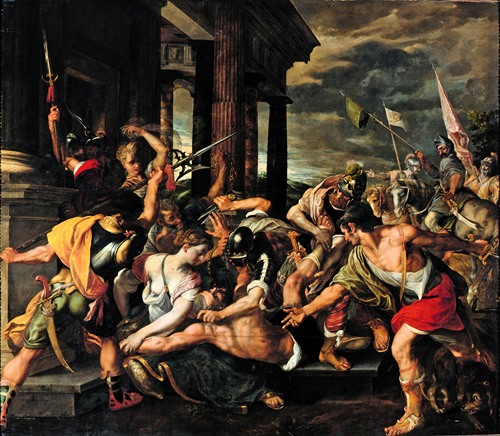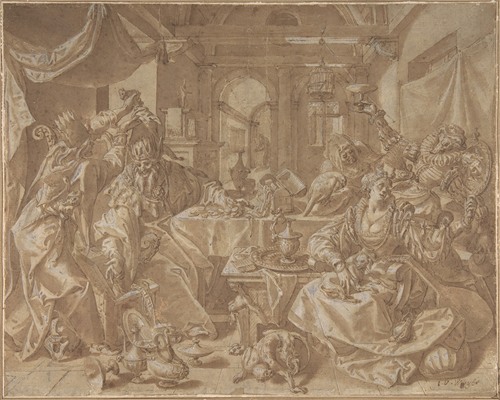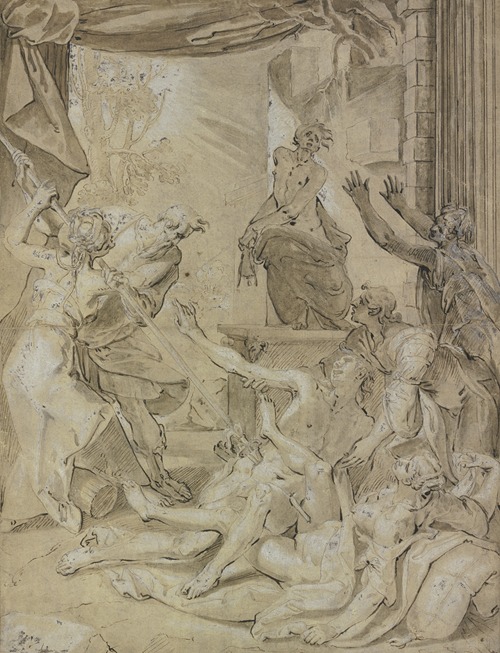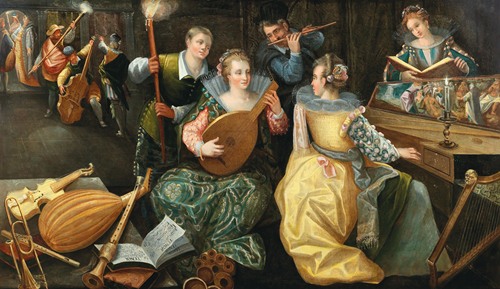
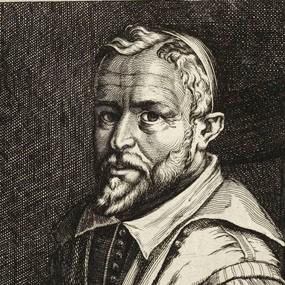

Joos van Winghe
Joos van Winghe, Jodocus a Winghe or Jodocus van Winghen was a Flemish painter and print designer. He is known for his history paintings, portraits, allegories and genre scenes, including merry companies. He worked in Brussels as court painter and left Flanders after the Fall of Antwerp in 1584. He then worked in Frankfurt for the remainder of his career. In Germany he enjoyed the patronage of Holy Roman emperor Rudolf II and adopted a more clearly Mannerist style.
The principal source on the life of Joos van Winghe is the Flemish contemporary art historian and artist Karel van Mander. Modern art historians treat van Mander's biographies of artists with circumspection. Van Mander recounts that van Winghe was born in Brussels in 1544. There is no independent information which can confirm this birth date.
Van Mander states that van Winghe traveled to Italy to further his studies. In Rome he lived with a cardinal for four years. Van Winghe spent time in Parma where he reportedly painted a fresco of the Last Supper in the refectory of the monastery of the Servites. He worked in the workshop of the Italian Mannerist painter Jacopo Bertoja who also employed the Flemish painter Bartholomaeus Spranger. Bertoja took van Winghe and Spranger to paint in the rooms of the Villa Farnese that he had been commissioned to finish. He also worked in Rome and Parma for Bertoja. A close friendship between Spranger and van Winghe must have developed during their time in Italy. A drawing by Spranger after a painting van Winghe, which has disappeared today, proves that the two artists remained in contact decades later, when Spranger had been court painter to Rudolph II in Prague for many years and van Winghe had settled in Frankfurt.
On his return trip he passed by Paris. He spent time at Fontainebleau where he was exposed to the Mannerist style of the School of Fontainebleau. His period of travel is situated between 1564 and 1568. Flemish painter Hendrick de Clerck may have been van Winghe's pupil during his stay in Italy.
After his return to Brussels in 1568 he became court painter to Alexander Farnese, Duke of Parma, then the governor-general of the Spanish Netherlands. He created a number of religious compositions during his stay in Brussels. He married with Catharina van der Borcht, who was a member of the van der Borcht family of painters. Their son Jeremias van Winghe later became a painter. He left his home country with his family in 1584 after the Fall of Antwerp and his position as court painter was taken up by Otto van Veen. The fact that he left Flanders after the recapturing of Antwerp indicates that he was a Protestant. A painted allegory described by van Mander depicting a chained personification of Belgica, i.e. the Netherlands, supports the view that his emigration was politically motivated.
He settled in Frankfurt, where he became a citizen (burgher) in 1588. In Frankfurt he was part of the large contingent of Flemish artists who had left their home country for religious reasons, such as Hans Vredeman de Vries, Marten van Valckenborch and his sons Frederik van Valckenborch and Lucas van Valckenborch, Joris Hoefnagel and Jacob Hoefnagel. There were also a great number of Flemish printmakers in Frankfurt. Many of the artists were tied together through a network of family relationships established through intermarriage. The exiled artists regularly worked together on projects where each artist would contribute to a painting the portion in which they were specialised. For instance, a figure painter and still life painter would contribute respectively the figures and still life elements in a painting. The artists would also provide designs for the publications engraved by the Flemish printmakers established in Frankfurt. Van Winghe further maintained close relations with the group of Flemish artists in Frankenthal through Hendrik Gijsmans, with whom he was related by marriage, through his younger brother Maximilian van Winghe, who lived in Frankenthal and through his marriage to Catharina van der Borcht, which connected him with the painter family of van der Borcht. Van Winghe likely enjoyed the patronage of Holy Roman emperor Rudolf II thanks to his friend Spranger who was court painter. Spranger may have been instrumental in the purchase of van Winghe's painting Apelles paints Campaspe before Alexander for the imperial collection and a series of twelve apostles designed by him, which was dedicated to Archbishop Berka in Prague.
He was the father of the painter Jeremias van Winghe who remained active in Frankfurt.
He died in Frankfurt in 1603.

